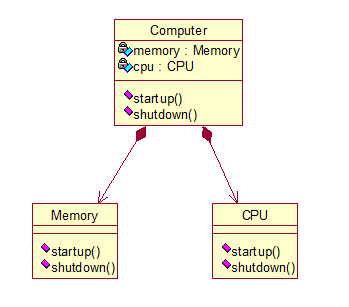(九)外观模式建模与实现
最后更新于:2022-04-01 09:31:17
外观模式(Facade):是为了解决类与类之间的依赖关系的,像spring一样,可以将类与类之间的关系配置到配置文件中,而外观模式就是将他们的
关系放在一个Facade类中,降低了类与类之间的耦合度,该模式中没有涉及到接口。
##一、uml建模:

##二、代码实现:
~~~
/**
* 示例:外观模式,也称门面模式
*
* 优点:为了解决类与类之间的依赖关系,降低了类与类之间的耦合度
*
* 该模式中没有涉及到接口
*/
class Memory {
public void startup() {
System.out.println("this is memory startup...");
}
public void shutdown() {
System.out.println("this is memory shutdown...");
}
}
class CPU {
public void startup() {
System.out.println("this is CPU startup...");
}
public void shutdown() {
System.out.println("this is CPU shutdown...");
}
}
/**
* 作为facade,持有Memory、CPU的实例
*
* 任务让Computer帮咱们处理,我们无需直接和Memory、CPU打交道
*
* 这里有点像去商店里买东西:咱们买东西只需要到商店去买,而无需去生产厂家那里买。
*
* 商店就可以称为是一个facade外观(门面)模式。--> 商品都在商店里
*/
class Computer {
private Memory memory;
private CPU cpu;
public Computer() {
memory = new Memory();
cpu = new CPU();
}
public void startup() {
System.out.println("begin to start the computer...");
memory.startup();
cpu.startup();
System.out.println("computer start finished...");
}
public void shutdown() {
System.out.println("begin to close the computer...");
memory.shutdown();
cpu.shutdown();
System.out.println("computer close finished...");
}
}
/**
* 客户端测试类
*
* @author Leo
*/
public class Test {
public static void main(String[] args) {
Computer computer = new Computer();
computer.startup();
System.out.println("\n");
computer.shutdown();
}
}
~~~
##三、总结
如果我们没有Computer类,那么,CPU、Memory他们之间将会相互持有实例,产生关系,这样会造成严重的依赖,修改一个类,可能会带来其他类的修改,这不是咱们想要看到的,有了Computer类,他们之间的关系被放在了Computer类里,这样就起到了解耦的作用,这就是外观Facade模式。